Cannonball jellyfish (Stomolophus meleagris) are also called cabbage-head jellyfish. These sea jellies are found in warm coastal waters worldwide. These marine animals are well-known due to their distinctive rounded bell shapes.
Cannonball jellyfish are popularly known for their relatively mild stings. These are often used as a source of food in certain cultures. Their sizes are similar to cannonballs. These are the species of jellyfish that belong to the family Stomolophidae.
Do you want to know how they are commercially important to us? Or do you intend to know about their complete biography? Just stay in touch here. We are about to unfold all the secrets of this remarkable species of jellyfish in this article. Just sit back, eat your snacks, and read on to know about this beautiful cannonball.
About Cannonball Jellyfish – A Quick Biology
Here is a quick biology table that you can review about cannonball jellyfish. Don’t worry, we have covered the encyclopedia in the below section. (Source)
| Parameters | Details |
| Scientific name | Stomolophus Meleagris |
| Kingdom | Animalia |
| Family | Stomolophidae |
| Genus | Stomolophus |
| Phylum | Cnidaria |
| Class | Scyphozoa |
| Order | Rhizostomeae |
| Species | Stomolophus Meleagris |
| Habitat | Pacific Ocean, mid-west Atlantic Ocean, coasts of United States |
| Life Span | Three to six months |
| Diet | Zooplankton, red drum larvae |
| Geographical range | From the Pacific Ocean to the Atlantic Ocean and the Gulf of Mexico |
Description And Distribution of Cannonball Jellyfish
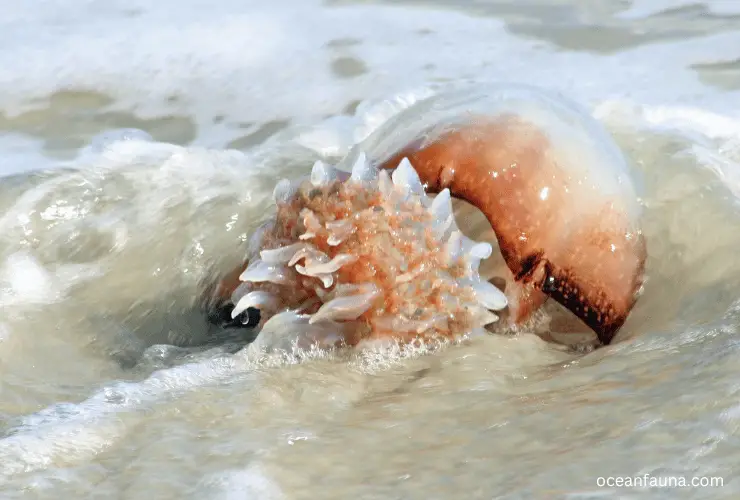
The Latin name of cannonball jellyfish means “many-mouthed hunter”. This name gives an apt description of this voracious species of jellyfish. It also shows its rapid speed of moving in the water.
This many-mouthed hunter can easily grow as large as eight to ten inches in diameter. According to web.archive.org’s research, the cannonball jellyfish looks like an oval-shaped milky mushroom. If we talk about its distribution, then these cannonballs are found in warm waters all over the world.
These are playing an active role in the supply of food for humans and other marine animals. The Atlantic Ocean, Pacific Ocean, Gulf of Mexico, Indian Ocean, Caribbean Sea, and the Coasts of the United States are their homes.
Anatomy / Physical Characteristics of Cannonball Jellyfish
Cannonball jellyfish were named after the fact that they tended to resemble a cannonball when curled up. Their diameters are 25 centimeters (10 inches). Also, their bells are dome shaped. The rims of cannonball jellyfish are usually covered with pigments. These pigments are usually colored brown.
More interesting, let’s talk about those cannonball jellies that are in the Pacific. They have blue pigments on their rims. The cannonball jellyfish also have oral arms underneath their bodies. These oral arms are in the form of clusters that are extended around their mouths.
Also Read: Blue Button Jellyfish (Porpita porpita): Habitat, Diet And Facts
According to archive.org researchers, the oral arms of jellyball are helpful in catching prey and to function easily in propulsion. These creatures have round bodies and short arms. Their arms have tentacles containing poisonous stinging cells.
Behaviors of Cannonball Jellyfish
Here are a few common behaviors in all cannonball jellyfish:
Vertical Migration Behavior
In this behavior, the cannonball jellyfish can migrate vertically in the water. Vertical migration happens due to changes in temperature and light. These sea jellies start moving toward the water surface at night for eating plankton. The cannonball jellyfish return to deep water during the day in order to avoid predators.
Aggregation Behavior
Cannonball jellyfish can aggregate in “blooms” (large groups). These blooms contain millions of individuals. This aggregation behavior is influenced by environmental factors like nutrient levels and water temperature.
Attachment Behavior
Cannonball jellyfish can attach themselves to hard surfaces with the help of the specialized cells on their tentacles. The hard surfaces could be rocks, shells, and even other jellyfish. This attachment behavior helps them to remain in a stable position in the water.
Shrinking Behavior
In shrinking behavior, the cannonball jellies contract their bells in order to reduce their size. Shrinking behavior is very useful for cannonball jellyfish to avoid predators, as it makes them difficult to detect.
These creatures can shrink their sizes by as much as 33 percent. However, this behavior is energetically costly for these sea jellies as they need to expand their energy for the contraction of bells.
We can imagine from jellyball’s behaviors that these tiny creatures are so intelligent and adaptive towards their environment.
Habitat and Range of Cannonball Jellyfish
Cannonball jellyfish are inhabitants of the Atlantic and Caribbean. These are also found in North America to Brazil (ranging from New England to Brazil). These cannonballs are also living on the coasts of the United States (southeastern coasts). It also includes the Gulf Coast.
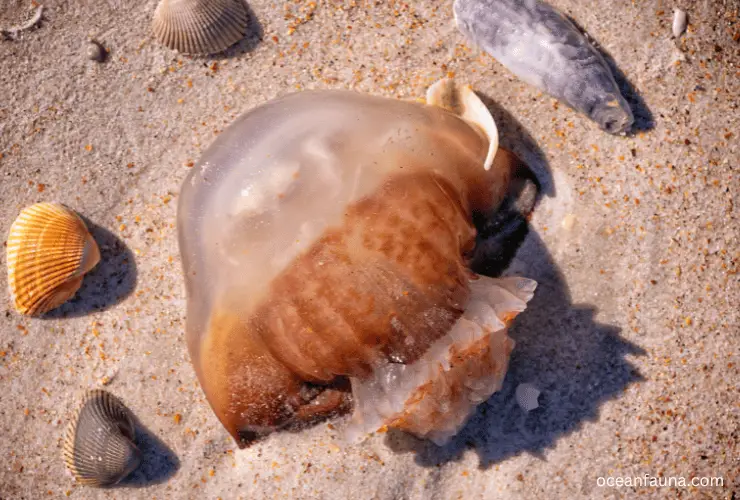
They also exist in various parts of the Pacific Ocean. In the Pacific Ocean, these sea jellies are mostly found in the following two ranges:
- South China Sea to the Sea of Japan
- California to Ecuador
Unlike deep-sea species, cannonball jellyfish prefer to live in shallow waters and beaches. If we talk about the southeast coasts of the US then these are abundantly available in the summer season and in the fall. Moreover, cannonball jellyfish constitute 16 percent of biomass in shallow areas during this timespan.
Feeding / Diet of Cannonball Jellyfish
According to the study, cannonball jellyfish mainly feed on zooplankton. These may include the veligers and any other form of red drum larvae. Thus, its diet consists of extremely small organisms that drift in the water column.
According to the study of Archive.org’s researchers, the cannonball jellyfish uses a specific technique to catch and eat its prey. Let’s see how these jellies catch and eat: (source)
As the jellyfish moves, it uses its bell to push water. It then guides the water across its oral arms. These arms are covered in sticky mucus, which catches small creatures like larval crabs and oysters.
The jellyfish feeds on these crustaceans. The mucus helps transport the food to the jellyfish’s mouth. The arms have many openings that lead to the mouth.”
Lifespan and Reproduction System of Cannonball Jellyfish
Cannonball jellyfish can reproduce both sexually and asexually. If we talk about the sexual reproduction process, then it starts when the cannonballs release sperm in the water from their mouth. These sperm will be caught by other species of cannonball jellyfish from their mouth.
This is how fertilization occurs externally in these species. Cannonball jellyfish have specialized pouches on their arms located right over their mouths. Now, the embryo will be developed and nourished in these special pouches. After some time (around 3 to 5 hours), the larvae will start talking to the bottom.
It will try to attach itself to the hardest structure. Here is the time when they start developing into polyps. These tiny polyps will catch and consume small prey that swims nearby. This process lasts for several days.
Now, the time comes when the polyps will be detached and converted into an ephyra that can swim easily. Eventually, the ephyra will be formed into a jiggly jelly – a cute adult jellyfish. Adult jellyfish are able to reproduce.
The life span of cannonball jellyfish is really interesting. According to Scientific Research, they can survive several years during their asexual reproduction period. However, their life span is very limited, only three to six months in their jellyfish stage.
Cardiovascular and Nervous System of Cannonball Jellyfish
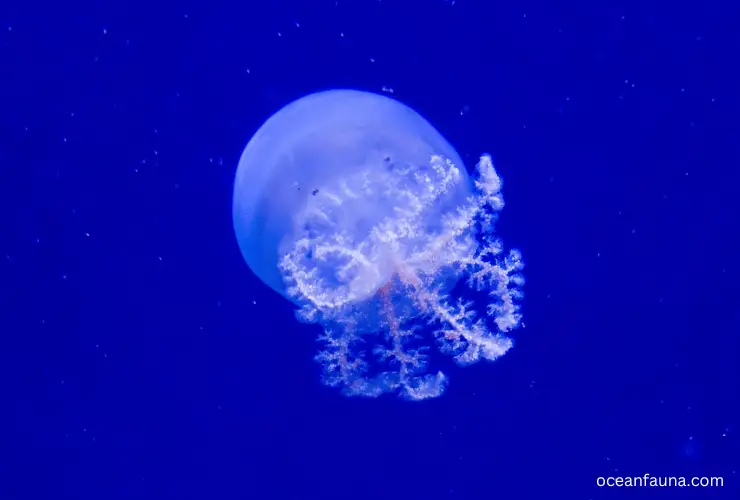
Let’s discover the cardiovascular and nervous systems of cannonball jellyfish separately:
Cardiovascular system
The cardiovascular system of cannonball jellyfish is very simple compared to other animals. It comprises a sac-like structure called the gastrovascular cavity. It does not have a heart that pumps blood like other organisms.
This cavity functions as both the digestive and circulatory systems. Nutrients are usually absorbed through the lining of the cavity. The heartbeat of cannonball jellyfish propels the nutrient-rich water throughout the body.
Nervous system
The nervous system of Cannonball jellyfish is decentralized. It means they do not have a central brain. They have a simple nerve net that allows them to sense light, odor, and touch. The nerve net is all over their body.
These jellies have a group of nerve cells that work like the brain. They use their nerve cells to coordinate movement and avoid danger. Jellyfish can regenerate lost nerve cells.
Commercial Fishing of Cannonball Jellyfish
In the southern United States, cannonball jellyfish are harvested in tons. This is one of the valuable exports in Georgia. These are dried, preserved, and packed before selling and exporting to Thailand, China, and Japan.
Modified nets are used in Georgia for trapping these sea jellies. Recently, these jellies are in bloom on the coasts of Mexico. According to the study, 20,000 tons of cannonball jellyfish were harvested in 2012 from April to July. These resources are blessings for the economy.
Predators of Cannonball Jellyfish
According to the study of Springer’s article, humans and leatherback sea turtles are the main predators of cannonball jellyfish. However, leatherback sea turtles are an endangered species that do not do much harm to these jellies.
Here is a quick review table about the known predators of cannonball jellyfish:
| Predators | Description | Geographical range |
| Sea Turtles | The known species of sea turtles that feed on cannonball jellyfish include leatherback, green, and loggerhead sea turtles. | Global distribution |
| Sunfish | Ocean sunfish that consume the cannonball jellyfish as a whole include Mola mola. | Global distribution |
| Spiny dogfish | The species of small sharks have been observed feeding on these sea jellies in laboratory experiments. | Atlantic Ocean |
| Oceanic Birds | The species of oceanic birds that are feeding on cannonball jellyfish include shearwaters and petrels. | Global distribution |
| Other Jellyfish | The species of other jellyfish that can eat cannonball jellyfish include moon jellyfish (Aurelia aurita). | Global distribution |
| Humans | Humans are not natural predators of these jellies. However, cannonball jellyfish are harvested in various parts all over the world for food, captivity, and research. Unintentional activities of humans like boating, fishing, and beach activities can also harm their population. | Global distribution |
Relationship with Humans
Cannonball jellyfish are less harmful to humans. That’s the reason why humans love to eat them. These are also easy to catch by humans due to their habitat of living closer to beaches and shallow waters.
Here are some other unique relationships of cannonball jellyfish with humans:
Non-lethal Sting: cannonball jellyfish are non-lethal species of jellyfish to humans. However, these jellies can still leave rashes, pain, and irritation after they sting.
Economic Importance: We have mentioned before, cannonball jellyfish are consumed as food in various countries. So, these are harvested and sold and give economic benefits.
Tourist Attractions: Cannonball jellyfish are tourist attractions in various parts worldwide. These jellyfish can be observed in their natural habitat.
According to the study, millions of jellyfish gather in Georgia in spring/fall. They clog shrimp nets but do not harm humans. These jellyfish are cannonballs and do not sting without any reason.
Cannonball Jellyfish Fun Facts
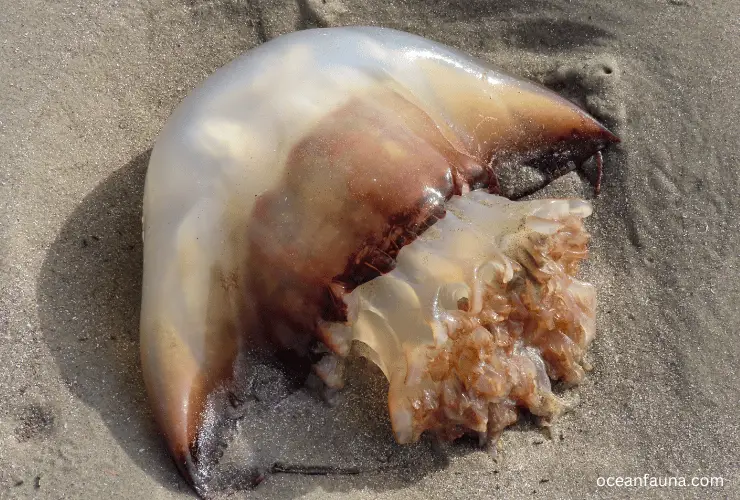
Here are a few fun facts about cannonball jellyfish that will amaze you: (source)
- The Turtle Excluder Device (TED) is used to keep cannonball jellyfish.
- Leatherback turtles are the biggest and exclusive predator of jellyball.
- Cannonball jellyfish is served on Asian tables for hundreds of years. These are traditional food sources in various countries.
- Cannonball jellyfish are used in medicines for soothing bronchitis and arthritis. These are also used in medicines to lower blood pressure.
- Asians called the cannonball jellyfish “music to the teeth” due to their crunchy texture after cooking. Bon Appetit!
- The weight of a cannonball jellyfish is about 20 to 25 ounces.
- Their bodies contain 95 percent water and 5 percent other substances.
- Cannonball jellyfish are strong swimmers, either horizontally or directionally.
- Cannonball jellyfish are also blue sometimes.
Does A Cannonball Jellyfish Sting Hurt?
Yes. The sting of a cannonball jellyfish can hurt you. It can cause mild pain and discomfort. You can use hot water and vinegar to help reduce the pain and irritation.
Toxin of Cannonball Jellyfish
Although its toxin is less lethal for humans and only works on small organisms, it can still cause problems. Its nematocysts can secrete mucus that contains toxins. The toxin of cannibal jellyfish can directly affect the eyes.
Cannonball Jellyfish Sting Effects
Although cannonball jellyfish do not sting humans, still, they can cause health issues if stung humans. Their toxin can cause cardiac issues in humans and other animals. It can interrupt the regular rhythms of the heartbeat and cause severe issues in the pathway of myocardial conduction.
Other species of Cnidaria can also result in similar types of effects on humans and animals that are being stung by them. Avoiding direct contact with these sea jellies is beneficial. It can also cause redness in the eyes. Itchiness on the skin is also common.
Also, seek medical assistance if stung by a cannonball jellyfish. Should not avoid any symptoms. These harmless creatures can be harmful sometimes. In the United States and the Caribbean, these are the most commonly known cause of more stings.
Can Cannonball Jellyfish Sting When Dead?
Yes, cannonball jellyfish can sting even if they are dead. Their tentacles can release toxins and you can be affected by a dead jellyfish. It is important to avoid touching either a life or a dead jellyfish.
If you ever come in contact with a dead cannonball jellyfish, wash that contact area. You can also seek advice from a healthcare worker if stung.
Are Cannonball Jellyfish Rare or Endangered?
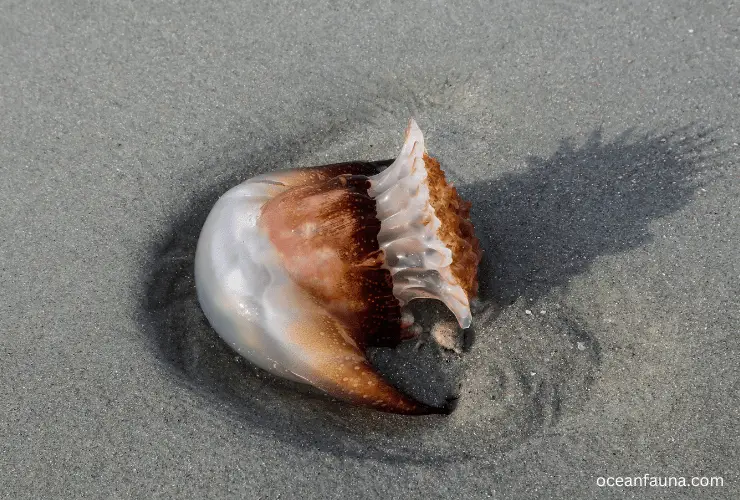
Cannonball jellyfish are neither rare nor endangered. It is because these are not investigated or evaluated well by the IUCN Red List. Their estimated population status is still unknown.
However, these are abundant in various parts of the world and harvested in tons. Still, it is essential to monitor their health and abundance in order to ensure the sustainability of the ecosystem.
Thousands of Cannonball Jellyfish Wash Ashore After Swarming North Carolina’s Outer Banks
According to LiveScience news, thousands of wacky cannonball jellyfish were washed ashore right after swarming the outer banks of North Carolina. This jamboree was the outcome of the spawning event of red drum larvae. The jellyfish jamboree happened along the northern side of Ocracoke Island.
This island is actually making up the Outer Banks. These squishy blobs were blooming there due to the presence of Sciaenops ocellatus. This larva of fish is the cannonball jellyfish’s favorite food. The same happens at the north end of Tybee Island where thousands of cannibal jellyfish were piled up.
The Cannonball Jellyfish and Spider Crab’s Amazing Relationship
The cannonball jellyfish and spider crab have a very interesting mutual relationship. This is known as a symbiotic relationship between them. Let’s see what we have found in a video of “Nature At Your Door” where a crab and a cannonball jellyfish’s symbiotic relationship is explained very well.
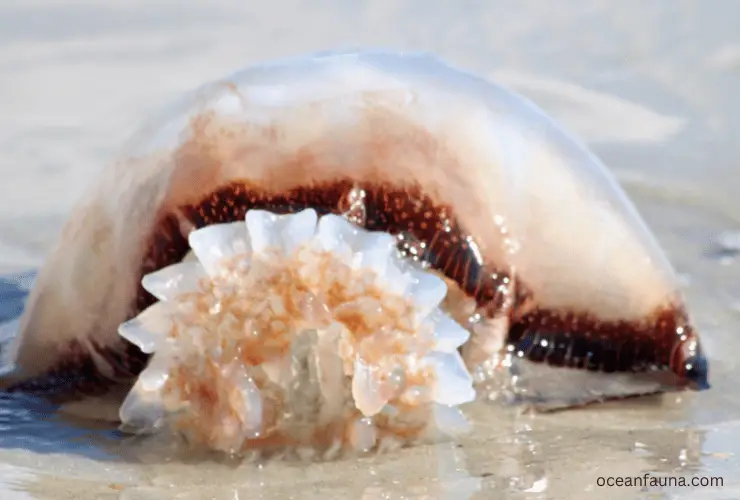
In this relationship, a spider crab sits at the back of a jellyfish for protection from predators. In return, the crab provides extra food to the jellyfish. This relationship is very unique because cannonball jellyfish are known as solitary creatures and do not interact with other sea species.
The spider crab also gets food from the net-like mouthparts of the cannonball jellyfish. The crab eats the parasites and other small organisms that are found on the body of this jellyball. In return, the crab protects the jellyfish from sunlight and sometimes provides extra food.
FAQs
How poisonous are cannonball jellyfish?
Cannonball jellyfish are generally not highly poisonous. However, these are mildly poisonous creatures and can cause vomiting, itching, redness, and discomfort. It is worth considering that the severity of their symptoms depends on various factors like the size of the victim, the amount of venom, and the sensitivity of the individual.
Can you touch a cannonball jellyfish?
You can touch a Cannonball Jellyfish, but you should not touch it out of curiosity. Even though they are not dangerous, it is not recommended to touch them.
Are cannonball jellyfish good to eat?
Yes. Cannonball Jellyfish are good to eat. They are known as edible species of jellyfish. However, they can be bad for many people, especially those who are allergic to seafood.
What are cannonball jellyfish good for?
Cannonball jellyfish play an important role in the ecosystem. They eat small organisms and other sea creatures eat these jellies. This is how the ecosystem balances. They are also consumed as food for humans in various countries globally.
Can cannonball jellyfish swim?
Yes. Cannonball jellyfish are good swimmers. These jellyfish have more flexible and muscular bodies as compared to other sea jellies. It helps them to swim swiftly. They use their eight arms to swim and pump water to move easily.
Conclusion
Cannonball jellyfish are glamorous creatures of the oceans and play an equally distributed part in the ecosystem. They can be considered as the party snacks of the water. Moreover, they are stirring the oceans. If you are feeling adventurous, you can see them from a distance.
Our dear readers, if you have more queries in your brains, you can ask us. We would be happy to answer them. Just ask away!

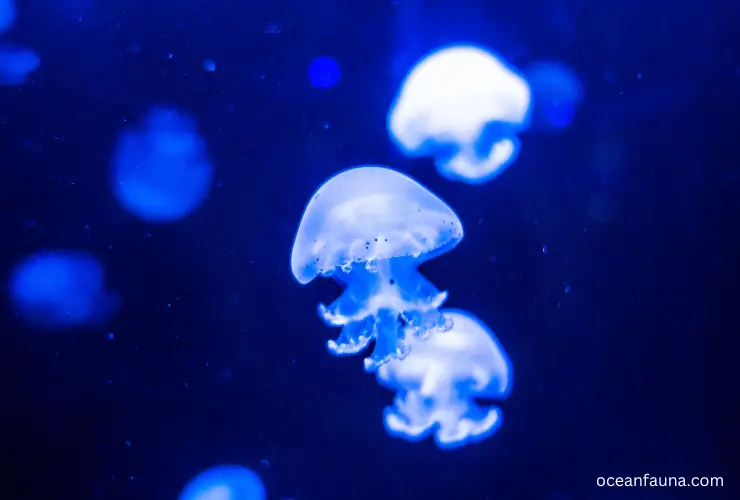
1 thought on “Cannonball Jellyfish: Habitat, Diet, Description & Facts”